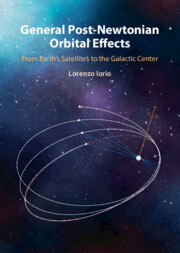Book contents
- Frontmatter
- Dedication
- Contents
- Acknowledgements
- 1 Introduction
- 2 General Calculational Scheme
- 3 1pN Gravitoelectric Effects: Mass Monopole(s)
- 4 2pN Gravitoelectric Effects: Mass Monopoles
- 5 1pN Gravitomagnetic Effects: Spin Dipole(s)
- 6 1pN Gravitomagnetic Effects: Spin Octupole
- 7 Newtonian Effects: Mass Quadrupole(s)
- 8 1pN Gravitoelectric Effects: Mass Quadrupole
- 9 pK Tidal Effects: Distant 3rd Body
- 10 Modified Models of Gravity: Orbital Precessions
- Appendix A List of Acronyms and Abbreviations
- Appendix B Notations and Definitions
- Appendix C pK Disturbing Functions from the Spacetime Metric
- Appendix D Spin-Orbit Orientation and Lorentz-Violating Coefficients
- Appendix E Coefficients of the Lense–Thirring Orbital Shifts
- Appendix F Coefficients of the Newtonian J2 Orbital Shifts
- Appendix G Coefficients of the Total Mixed Net Orbital Shifts of the Order of J2/c2
- Appendix H The Coefficients of the Tidal Orbital Precessions
- Appendix I Coefficients of the Power-Law Mass Density Profile Orbital Precessions
- Appendix J Numerical Values of Relevant Astronomical Parameters
- Appendix K Post-Keplerian Orbital Effects: Numerical Values
- Appendix L A Cursory Overview on Some Proposed Spacecraft-Based Missions
- References
- Author Index
- Subject Index
9 - pK Tidal Effects: Distant 3rd Body
Published online by Cambridge University Press: 28 November 2024
- Frontmatter
- Dedication
- Contents
- Acknowledgements
- 1 Introduction
- 2 General Calculational Scheme
- 3 1pN Gravitoelectric Effects: Mass Monopole(s)
- 4 2pN Gravitoelectric Effects: Mass Monopoles
- 5 1pN Gravitomagnetic Effects: Spin Dipole(s)
- 6 1pN Gravitomagnetic Effects: Spin Octupole
- 7 Newtonian Effects: Mass Quadrupole(s)
- 8 1pN Gravitoelectric Effects: Mass Quadrupole
- 9 pK Tidal Effects: Distant 3rd Body
- 10 Modified Models of Gravity: Orbital Precessions
- Appendix A List of Acronyms and Abbreviations
- Appendix B Notations and Definitions
- Appendix C pK Disturbing Functions from the Spacetime Metric
- Appendix D Spin-Orbit Orientation and Lorentz-Violating Coefficients
- Appendix E Coefficients of the Lense–Thirring Orbital Shifts
- Appendix F Coefficients of the Newtonian J2 Orbital Shifts
- Appendix G Coefficients of the Total Mixed Net Orbital Shifts of the Order of J2/c2
- Appendix H The Coefficients of the Tidal Orbital Precessions
- Appendix I Coefficients of the Power-Law Mass Density Profile Orbital Precessions
- Appendix J Numerical Values of Relevant Astronomical Parameters
- Appendix K Post-Keplerian Orbital Effects: Numerical Values
- Appendix L A Cursory Overview on Some Proposed Spacecraft-Based Missions
- References
- Author Index
- Subject Index
Summary
The precessions of the Keplerian orbital elements are calculated for several tidal-type accelerations due to the presence of a distant 3rd body: Newtonian, post-Newtonian gravitoelectric, and post-Newtonian gravitomagnetic. The calculation is made, first, in a kinematically and dynamically non-rotating frame. Then, it is repeated in a dynamically non-rotating and kinematically rotating frame accounting for the de Sitter–Fokker and Pugh–Schiff precessions of its axes.
Keywords
- Type
- Chapter
- Information
- General Post-Newtonian Orbital EffectsFrom Earth's Satellites to the Galactic Centre, pp. 155 - 164Publisher: Cambridge University PressPrint publication year: 2024

